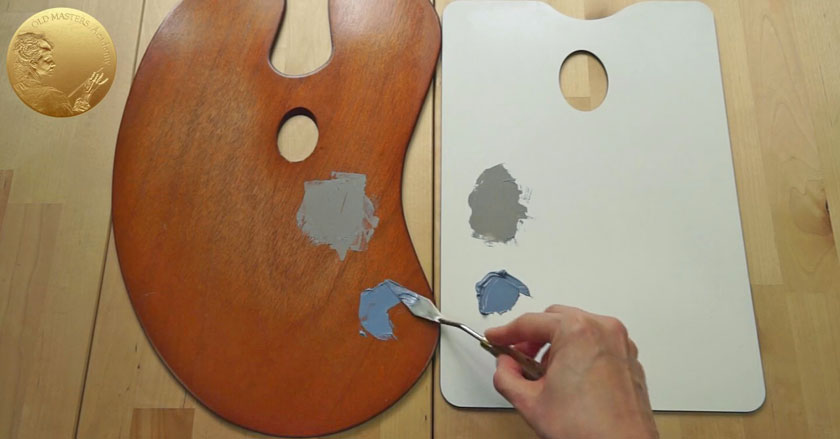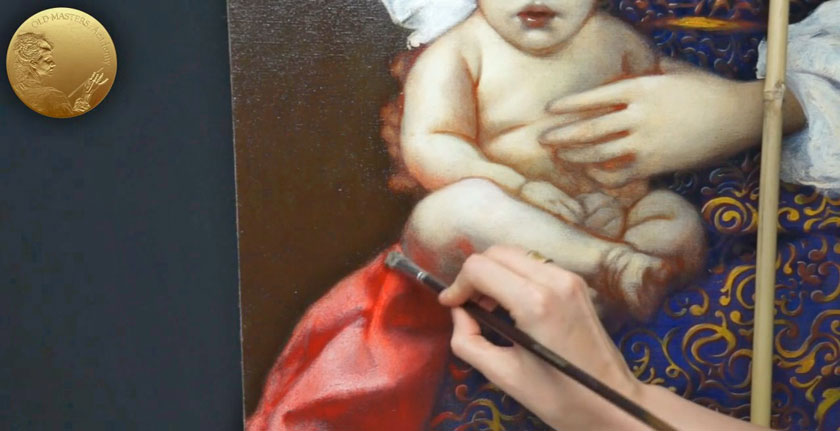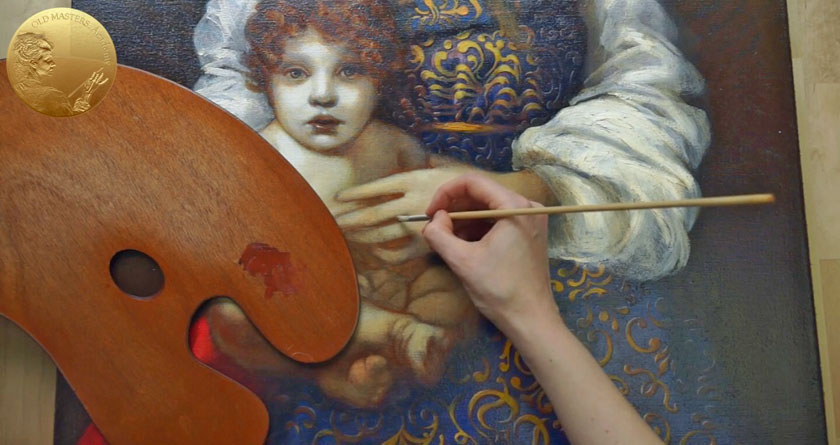what is mixed together to get oil paint?
Art Lesson 25
In this lesson, you will observe out the Basic Rules of Mixing Oil Paints
Learn how to paint like the Old Masters!
Old Masters Academy Online Course
Self-study, cocky-paced online video course
Lifetime membership
Ane-fourth dimension payment: $487
Enroll Now!
Personal Tutoring online + Online Class
Unlimited tutoring past the Academy teachers
Lifetime membership
One-time payment: $997
Enroll At present!
« Back to the Art Lessons Listing
Basic Rules of Mixing Oil Paints
There are some practical recommendations for mixing Colors that can aid you during the painting process. It takes feel to realize what kind of small tricks tin assistance you in mixing. Simply why should we reinvent the bike? These small tips listed below could exist very efficient for us; and somewhen, in that location volition be less frustration while paining and less paint will be wasted.



- If you need to mix a Dark Color with a Light ane – for case, permit'due south say you want to become a light Blueish past mixing White and Ultramarine. Have White in a quantity yous find will exist enough to cover the area you want, and add a bit of Blueish to information technology. If you practice information technology the other fashion circular – add White to Ultramarine – you will be forced to bring in a significantly larger amount of White till yous brand the Bluish light enough. So, add Nighttime Colors to Lights – y'all will be in charge of the amount of Pigment and manipulating the irresolute Hue more efficiently.
- The Opacity of Pigment besides plays a significant role in the effective mixing process. We add Opaque Colors to Transparent Colors. Opaque Colors have much bigger roofing power, and they require a very large corporeality of Transparent Color to influence them. All the same, it'due south enough to add just a bit of Opaque Color to influence the Transparent Color.
- The more Colors there are in the Pigment mix, the less stable that mix is, chemically. This tin negatively affect the preservation of the painting Coloring in the long perspective. And some other downside of mixing too many Colors together is that the resulting Color loses the freshness of the Colour and can get muddy and dirty. Ideally, at that place should be just two or iii different colors in the mix. More that can pollute the end-result Colour. If your Colour mix isn't coming out the mode y'all want, y'all should beginning again.
- While you lot try to mix the desired Color, you should exam it on the canvas past applying a pocket-size stroke to see how shut the mix is to the outcome you expect. The paint that appears to be the right Color mix on the Palette can await non equally perfect on the Canvas. The examination stroke helps you to evaluate what should exist added to the mix.
- The employ of the right Palette also plays a meaning part in effective mixing. At that place are two diffident Palettes we should have at our disposal – one is White and the other is Dark. Imagine you get-go the painting process and want to block in the White Canvas. For that reason, you should mix Colors on the White Palette – the Color mixes will look the same on a Palette as on the Canvass. The same Paint mixes on a Dark Palette will look lighter than they actually are. There is a danger that pigment that appeared appropriately low-cal on the Dark Palette will actually exist very dark when applied on the White Sheet. And vice versa – all Colors seem darker than they are on a White Palette; and then, when trying to mix the Colour for a painting that is already blocked in Dark Colors, use a Nighttime Palette.
- To intensify the Color – use Glazes. Zilch else can burnish the Color better than Glazings. And never add together White to the Color you desire to be bright and Intensive – it reduces the Intensity, making the Colour milky. White makes whatsoever transparent Colour Opaque.
- Tinting the Color mix by adding White into information technology could be perfectly fine and fifty-fifty advisable at the stage of Underglazing, equally the Underglazing should be Opaque and Colder before we finish it in Glazings.
- When you want brand the Colour mix darker, shade it – you should add together its opposite, a complementary Colour; for example, if you lot want to make a Green Color darker, you should add together a flake of Red into the Green in club to neutralize it a fleck, without causing an obvious shift in its Hue. If you darken the Green Color past calculation Black, you lot just have a chance to make your Greenish dreggy.
And at the terminate, I want to repeat: Tinting the Colour mix with White or Shading information technology with Black is an oversimplification that tin't bring out the beauty in the Colors we see in the Former Masters' paintings. But it tin can and must be used in Underglazing layers that will later on be over-painted with Glazings and Velaturas that bring vividness and richness to the painting. That's exactly what the Onetime Masters did, and we will borrow their procedure methods to our advantage.
Learn how to paint like the Former Masters!
Old Masters Academy Online Course
Self-written report, self-paced online video class
Lifetime membership
Erstwhile payment: $487
Enroll Now!
Personal Tutoring online + Online Course
Unlimited tutoring by the Academy teachers
Lifetime membership
One-time payment: $997
Enroll Now!
Source: https://oldmasters.academy/old-masters-academy-art-lessons/basic-rules-of-mixing-oil-paints